2020
- Seeking a cure for muscular dystrophy: Research contract with Sarepta Therapeutics, as stated on their web site:
“Sarepta has partnered with a renowned group of investigators at the University of Minnesota with the goal of advancing the understanding of dystrophin structure and function. Dr. Jim Ervasti, a leading expert on the structure and cellular function of the dystrophin glycoprotein complex, is collaborating with Dr. Joseph Muretta to leverage a novel fluorescence-based high throughput screening method developed by Dr. David Thomas. Combining their respective expertise in cell biology and biophysics could lead to new insights relevant to the critical functional domains within the dystrophin protein.” 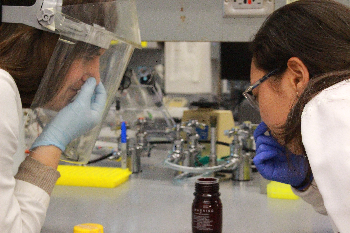
BMBB Awards for new PhDs: Congratulations Megan McCarthy and Lien Phung for receiving the Charles W. Carr & William J. Peterson Award, and Lien Phung on receiving the Victor Bloomfield Graduate Fellowship for the second year. Although the awards ceremony has been canceled this year, we are very proud of them and would like to recognize their accomplishments! Pictured to the right, Lien and Megan posing for a joke photo in the wetlab. Dr. Phung and Dr. McCarthy graduated in July, Lien returning to medical school to obtain her MD, Megan to a postdoc at Yale.
2019
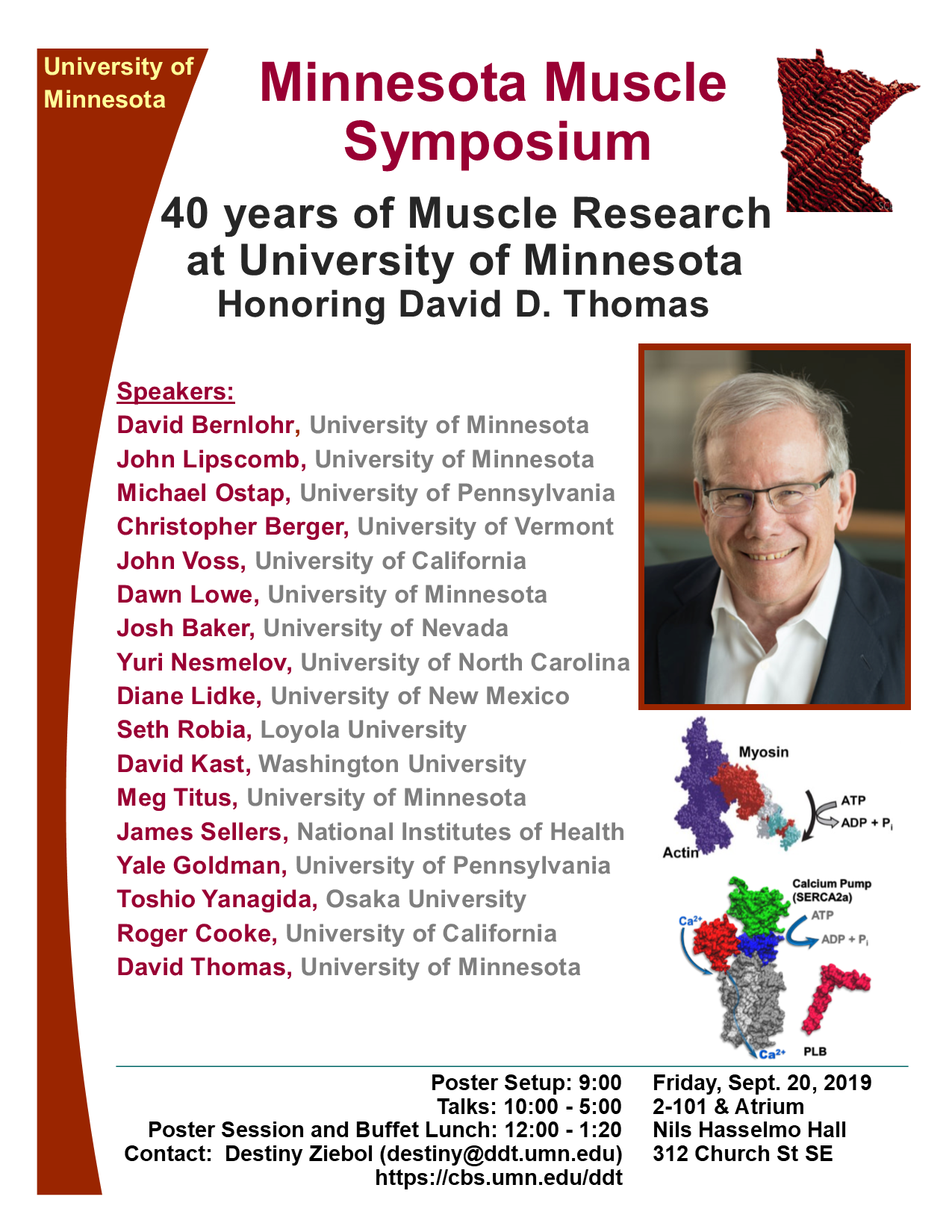
September: DDT celebrated his 70th birthday on Sept 18. On Sept 20 (his wedding anniversary), BMBB and the Thomas Lab hosted a symposium honoring Dave at UMN.
- This year we would like to congratulate the graduation of Dr. Mike Fealey and Dr. Chih Hung Lo, the two newest doctors from the Thomas lab!
- BMBB Awards 2019: This year we would like to congratulate Lien Phung for receiving the Victor Bloomfield Fellowship and the Cyrus Barnum Teaching award at the 2019 BMBB awards banquet. Great work Lien!
2018
- August: With the beginning of a new school year several DDT Lab graduates are starting their careers as professors:
- Ben Binder will be teaching at Augsburg University
- Cheng Her will be teaching at Metropolitan State University
- Jesse McCaffrey will also be teaching at Augsburg University
- John Rohde will be teaching at the University of St. Thomas
- 8/10: Dan Stroik has successfully defended his PhD. Congratulations Dr. Stroik!
- Piyali Guhathakurta was featured in an Author profile from JBC, when her paper with Ewa Prochniewicz, Ben Grant, Kurt Peterson and Dave Thomas was featured as the Editors pick on the cover of JBC and published with a commentary by Laura Gunther and Chris Yengo. See the cover, the commentary, and the paper here.
- Norma Jimenez Ramirez was accepted and will be matriculating into Stanford University School of Medicine with a Scholarship.
- Joe Duerr and Paul Thanel were both awarded a summer UROP for their work in the Thomas Lab.
- Ananya Tripathi, DDT lab undergraduate and Junior in the College of Science and Engineering, was nominated and accepted for membership into the UMN Chapter of Sigma Xi, the Scientific Research Honor Society and given the Sigma Xi UROP Student Member Award in recognition of her outstanding qualifications, promise and accomplishments in independent scientific research.
- 5/1: Science from Scientists, the education non-profit that thomas lab predoc Dan Stroik works with, was featured in the spring newsletter from the MN Chamber of Commerce. Great job Dan, in working to make this excellent organization flourish in Minnesota. Additionally, check out their video from the Saint Paul Public Schools.
- John Rohde was awarded a CBS 2018 Teaching Assistant Award for his work in Biochemistry 4521! To quote his student nominator: “It is very apparent that he takes quite a large chunk of time out of his busy schedule to put together thorough and enlightening review sessions. ... I have been here for three-and-a-half years and have taken about 160 credits worth of courses, but have never come across a teaching assistant as conscious or patient as John.”
04/27: Christine Karim
retired after 25 years of dedicated research in the Thomas Lab. In her words: "The opportunities I have had to go on scientific adventures from this home has been unparalleled and the experience deeply satisfying. I especially enjoyed sharing the excitement of many scientific discoveries with you, and the accompanying friendship. I thank all of you for being a part of this journey." We all wish her the best of luck in this new stage of her life. For more information about Christine, her research, as well as some absolutely fabulous photography, see her website at www.christinekarim.com.
- BMBB awards of 2018 Congratulations to our BMBB award recipients!
- Sami Chu was awarded Hogenkamp Award in Enzymology.
- Cheng Her was awarded the Ross A. Gortner Award.
- Megan McCarthy was awarded the Graduate Student Leadership Award as well as the Charles W. Carr & William J. Peterson Award.
- Lien Phung was awarded the Charles W. Carr & William J. Peterson Award.
- Robyn Rebbeck was awarded the Paul D. Boyer-James B. Peter Award – the only BMBB Postdoc award.
- John Rohde was awarded the Cyrus Barnum Teaching Award and the Victor Bloomfield Graduate Fellowship in Molecular Biophysics, both for a 2nd consecutive year.
04/09: Sam Carlson,
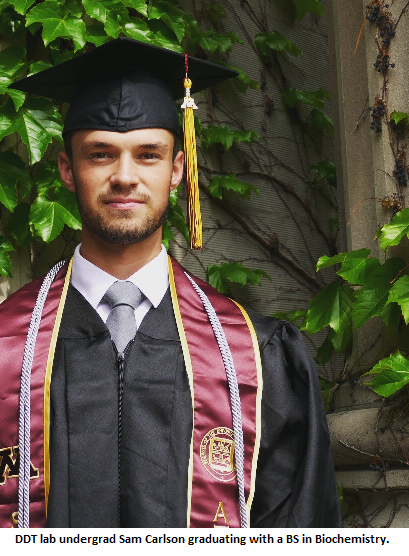
undergraduate scientist in DDTLAB since his freshman year, has been accepted to medical school at the Medical College of Wisconsin, matriculating in July 2018. Sam is a member of the UMN track and cross-country teams (Big Ten runner), and he has received numerous academic awards and honors while investigating calcium transport regulation in muscle and heart during his time in DDTLAB (two Biochemistry Scholarships, two Undergraduate Research Grants, one Directed Research semester, and a featured talk at the American College of Sport Medicine conference). Sam plans to specialize in sports medicine. Congratulations Sam!
2017
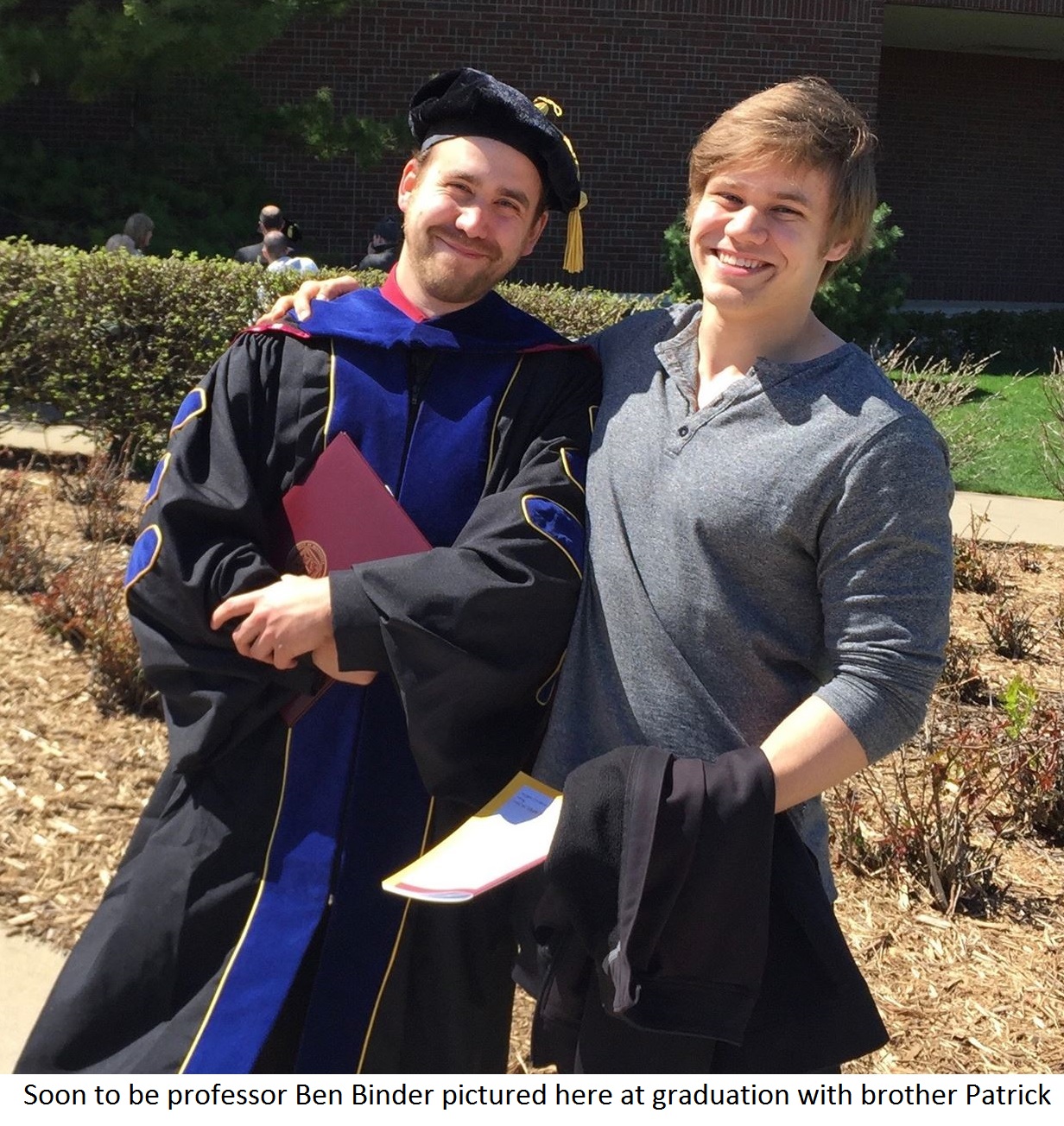
12/19: Postdoc Ben Binder accepted a position at Augsburg as a tenure-track Assistant Professor of Biochemistry, just in time to get lab space in their brand new building, the Hagfors Center for Science, Business and Religion. Look forward to seeing Professor Binder at Augsburg this coming August. Congratulations Ben!
On 8/1 the DDT lab commemorated the graduation of this years Lillehei students by going out to Izzy's Ice cream. The Lillehei Summer Scholars program brings highly qualified high schoolers and undergraduates to the cutting edge of research by placing them in active laboratory roles. Our scholars did excellent work this year. Appearing from left to right is Dan Stroik, Kian Dahlberg, Lien Phung, Megan McCarthy, Razvan Cornea, Opoku Akyeampong, Kevyn Janicek, Robyn Rebbeck, Claire Haskin, Gabrielle Evans.
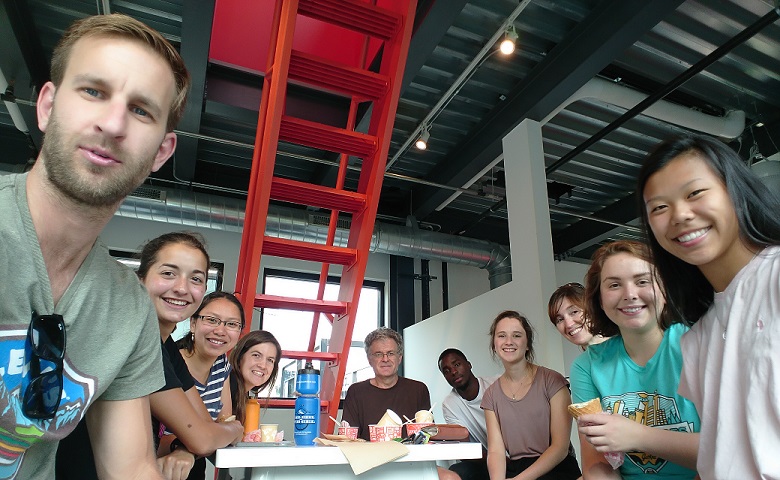
On 7/21 DDT lab celebrated the 30th anniversary of the Twins first world series win in 1987 by enjoying the Twins vs. Tigers Friday night game.
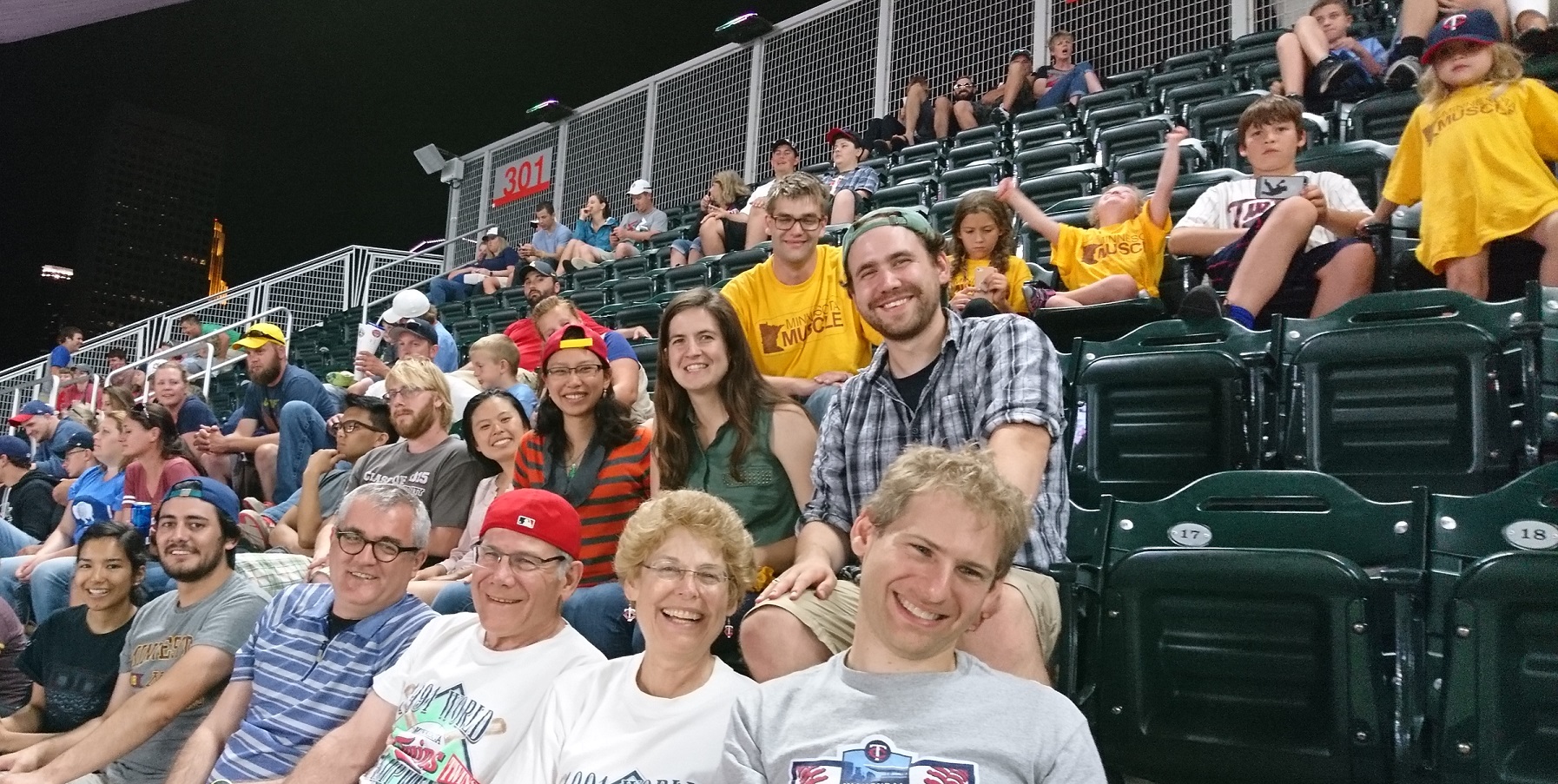
- Cheng Her was awarded the Doctoral Dissertation Fellowship for 2017-2018.
- BMBB awards of 2017 Listed from Left to Right:
Megan McCarthy received the Armstrong-Pothapragada Graduate Fellowship as well as the Graduate Student Leadership Award.
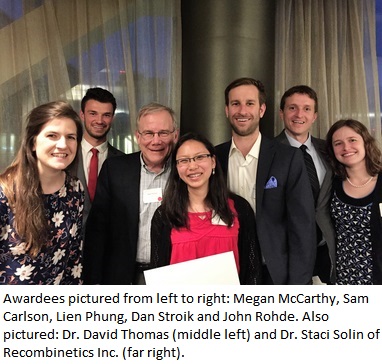
- Sam Carlson was awarded the CBS Annual Giving Scholarship for the second year in a row.
- Lien Phung received the Armstrong-Pothapragada Graduate Fellowship.
- Dan Stroik was awarded the BMBB Travel Award, Cyrus Barnum Teaching Award, and the Hogenkamp Award in Enzymology
John Rohde was awarded the Graduate Excellence Fellowship – College of Biological Science for the third year, the Cyrus Barnum Teaching Award, and the Victor Bloomfield Graduate
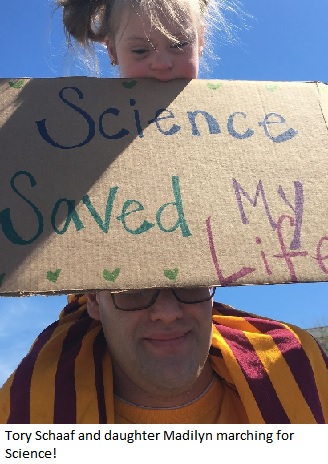
Fellowship in Molecular Biophysics.
- On 4/23 some of our prominent Thomas Lab members could be seen at the March for Science, speaking up for evidence biased policy and science funding.
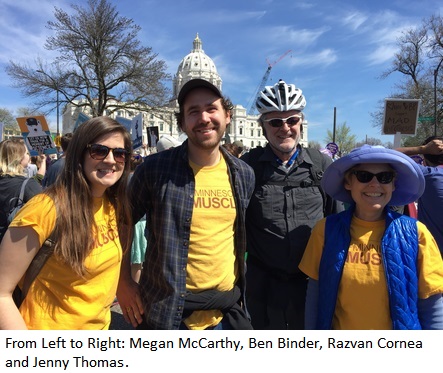
2016
Dave Thomas had his first DDT Grandchild: Gabriel, born in Pasadena on December 13 to daughter Melanie and son-in-law Alex.
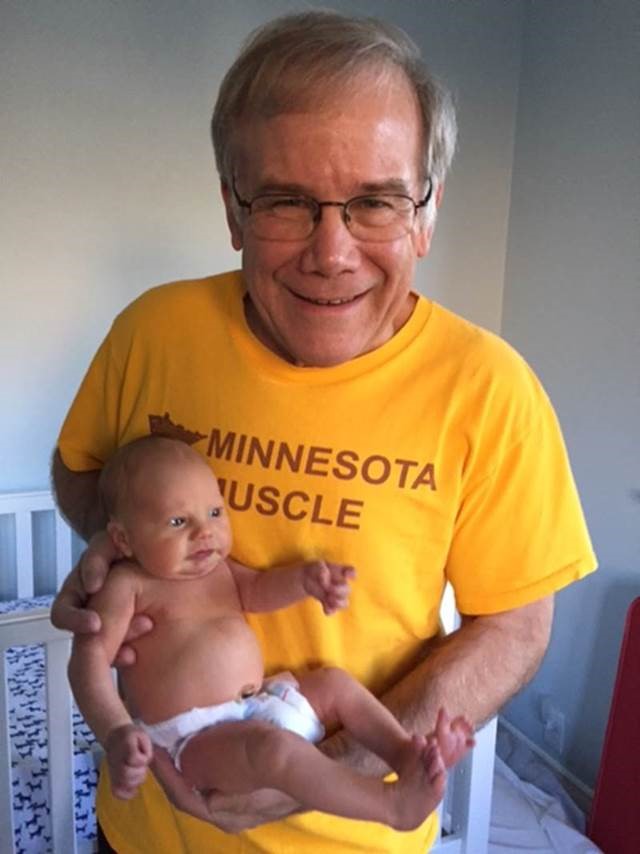
- Samuel Carlson was awarded an Undergraduate Research opportunity Grant (UROP) for three months of summer research on the anti-leukemia compound CXL017. Congrats Sam!
- Karl Petersen was awarded the Doctoral Dissertation Fellowship for 2016-2017. He successfully defended his PhD thesis in December, and in 2017 he will begin postdoctoral work in Paris with Anne Houdusse.
- Jesse McCaffrey current postdoc, PhD graduate in 2014, has been appointed to a faculty position in Physics at Augsburg College.
- Ewa Prochniewicz, Assistant Professor, is retiring September 30. Ewa has been an extremely productive DDTLAB member since 1992, leading our research efforts on actin biophysics. We will miss her, but she will continue to consult with us. She has established a strong research program in this area that will be continued by Piyali and others. To help celebrate her career, Ewa has been invited to give a lecture in December in Japan, where she did postdoctoral work for a decade before moving to DDTLAB.
- Undergraduate Shawn Anderson received a UROP (Undergraduate Research Opportunities Program) Scholarship for his work in the Thomas Lab.
- Undergraduate Meg Ryan received the a Gregory Marzolf Jr. Undergraduate Fellowship award.
- Robyn Rebbeck, postdoc, has been awarded a 2-year extension of her American Heart Association Postdoctoral Fellowship, for her studies of ryanodine receptor biophysics.
- BMBB awards of 2016 Listed in order of left to right:
- Cheng Her: Armstrong-Pothapragada Graduate Fellowship
- John Rhode: Ross A. Gortner Award, Graduate Excellence Fellowship
- Ben Binder: Victor Bloomfield Fellowship
- Tory Shaaf: Ross A. Gortner Award, 3M Science and Technology Fellowship, Arnold H. Johnson Fellowship
- Karl Petersen: Victor Bloomfield Graduate Fellowship in Molecular Biophysics - Second time awarded this fellowship!
- Dan Stroik: Charles Carr/William Peterson Award
Samuel Carlson: CBS Annual Giving Undergraduate Scholarship
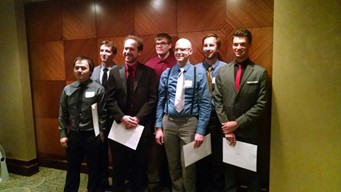
2015
- Mike Autry was named Director of the Biophysical Technology Center.
- Karl Petersen was awarded the Graduate Travel Award by the American Society for Cell Biology this December.
- Megan McCarthy, grad student, has been awarded a Predoctoral Fellowship by the American Heart Association, for her studies of ryanodine receptor regulation by calmodulin.
- Brett Colson, postdoc, has been appointed Assistant Professor of Cellular and Molecular Medicine at the University of Arizona.
- Undergraduate Meg Ryan received a UROP (Undergraduate Research Opportunities Program) Scholarship for her work in the Thomas Lab.
- BMBB awards of 2015:
- Ben Binder: Cyrus Barnum Teaching Award
- Tory Schaaf: 3M Science & Technology Fellowship, Arnold H. Johnson Fellowship
- Karl Peterson: Victor Bloomfield Fellowship
- John Rhode: Doctoral Dissertation Fellowship, Graduate Excellence Fellowship
- Dan Stroik: Graduate Student Leadership Award
2014
- Graduations: Drs. Simon Gruber (joined Hajjar Lab at Mount Sinai Medical School), Daphne Dong (joined Bers Lab at UC Davis), Zach James (joined Zagotta Lab at U Washington Seattle) and Jesse McCaffrey (continued as postdoc in Thomas Lab.)
- Robyn Rebbeck, postdoc, has been awarded a Postdoctoral Fellowship by the American Heart Association, for her studies of ryanodine receptor biophysics.
- Brett Colson, postdoc, has been awarded a K99/R00 Pathway to Independence grant from NIH.
- Tory Schaaf, grad student, has been appointed to the Chemical biology Interface Training Grant.
- Joseph Muretta, Assistant Professor, has been awarded a Scientist Development Award from the American Heart Association.
- BMBB awards of 2014:
- Tory Schaaf: 3M Science & Technology Fellowship, Charles W. Carr & William J. Peterson Award, Arnold H. Johnson Fellowship
- Dan Stroik: Graduate Student Leadership Award
Polar Vortex Strikes Minnesota Muscle in first days of January.
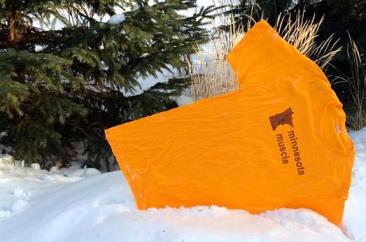
2013
- Brett Colson, postdoc, has been awarded a postdoctoral fellowship from the America Heart Association.
- Cheng Her was awarded the Diversity of Views and Experiences (DOVE) award through 2014. Congratulations Cheng!
- Mike Autry was elected Postdoc Liaison, representing all 600 postdocs at the Faculty Senate.
- Naa-Adjeley Ablorh, Rebecca Moen, Simon Gruber, and Zach James, graduate students in Thomas Lab all received their PhD this summer. It’s hard to leave a lab like ours, so they stayed as postdocs, except for Rebecca, who began a tenure-track professor position at Mankato State University in Chemistry. Good luck!
- Matt Mauseth (first-year grad student in DDTLAB) coached a Minnesota High School wrestling team to championship.
- DDT’s long-standing NIH R01 grants were both renewed, with scores in the top 3%: “Structural Dynamics of Muscle Calcium ATPase Regulation” is in its 34th year, and “Structural Dynamics of Muscle Contraction” is in its 30th year.
- DDT and David Bernlohr are PIs of a new grant to discover and develop SERCA activators for treatment of Diabetes, offered by the “Decade of Discovery in Diabetes” 2013 Discovery Transformation Program.
- DDT was inducted into the Academy for Excellence in Health Research, at a ceremony in the Medical School on October 29th.
- BMBB Awards for 2013:
- Naa-Adjeley Ablorh: Thomas Reid Award
- Tory Schaaf: Arnold H. Johnson Fellowship
2012
- Ryan Mello, graduate student in the lab, successfully defended his PhD thesis in May 2012. He is now a medical student at the University of Minnesota. Ryan published his thesis work in Biophysical Journal. The discipline and rigorous work he mastered in this lab will help him become a scientifically astute physician.
- John Rubin, undergraduate research assistant in the lab, worked for 4 years under the supervision of Dr. Mike Autry and has co-authored two articles published in JBC. He was admitted into the New York Medical College for the fall semester.
- Jennifer Klein, former grad student and postdoc, has successfully navigated the tumultuous waters of academia and has begun a tenure-track assistant professorship in Chemistry at University of Wisconsin, LaCrosse.
- Greg Gillispie moved his company, Fluorescence Innovations, to Minneapolis, and became Associate Professor in BMBB and Co-Director of Biophysical Spectroscopy Center.
- DDT received perfect scores (10) for two NIH grant applications (R21 and T32.)
- Awards for DDTLAB members Congratulations to the following lab members for awards in 2012:
- Mike Autry - Best Talk, Iowa State University Postdoc Day (2011), Postdoc Mentor Award, HHMI-CBS (2012)
- John Rubin - Matriculating into Med School (Fall 2012)
- Nick DesLauriers - HHMI-CBS Undergraduate Research Award (Spring 2012), UMN Undergraduate Research Award aka UROP (Summer 2012)
- Christine Karim, DDTLAB collaborator and Research Associate Professor, is featured in the Biophysical Society Newsletter in April, 2012. In Biophysicist in Profile, Christine's interesting life and research career are described.
- Ava Yun Lin, MD/PhD student who will defend her thesis in June has been awarded the Milne-Brandenburg Award for the outstanding PhD thesis in the Medical School. In the past year, Ava has recently published three papers on her research on the molecular biophysics of muscular dystrophy, in PNAS and J Mol Biol. Lin et al., 2011, Henderson et al., 2011, and Lin et al., 2012. Her discoveries have initiated a new era in the muscular dystrophy field, in which molecular biophysics informs strategies for therapeutic advances in treating the most devastating muscle disease – Duchenne muscular dystrophy.
2011
- DDT has received a MERIT (Method to Extend Research In Time) Award from NIH for his proposal, Site-Directed Oxidative Modification of Muscle Protein Structural Dynamics (from NIA, National Institute of Aging). Instead of the standard 5-year award, this grant will be renewed (almost) automatically for a period of 10 years. This is the highest award an investigator can receive based on a R01 research grant; indeed, it has been renumbered as an R37 grant. This is the second time DDT has received a MERIT award. From 1993-2003, he received MERIT from NIAMS for "Molecular Dynamics of Muscle Contraction."
- Another honor for Michel! Dr. Lennane Michel Espinoza-Fonseca, who was recently awarded the National Youth Prize of Mexico (see below), has now been awarded the title of National Researcher (Investigador Nacional) by the Mexican Government. This is a prestigious award that recognizes Michel's outstanding scientific productivity and international leadership in his field.
- Biophysical Assault on Heart Failure: several developments have combined to inspire the DDTLAB to redirect its efforts in the direction of therapeutic development for heart failure, using the principles of and technologies of structural biophysics that have been pioneered in this lab.
- High-performance time-resolved fluorescence: This instrument, (constructed in collaboration with Fluorescence Innovations, Inc.) uses direct waveform recording to acquire a high-quality sub-nanosecond time-resolved fluorescence waveform every 0.1 ms, which is a factor of 100,000 times faster than in current commercial instruments. Time resolution increases the precision of fluorescence detection by an order of magnitude, and the time-resolved fluorescence waveform is rich in information, especially when it corresponds to FRET, where it provides direct and independent information about structural and thermodynamic parameters of the system. We have applied this to resolve structural states in the SERCA-PLB system Lockamy et al., 2011, myosin light chain domain, Kast et al., 2010, and myosin catalytic domain Agafonov et al., 2010.
- Fluorescence Lifetime Plate Reader: This instrument is being developed in collaboration with Fluorescence Innovations, and a prototype has been installed in the BTC. It performs an HPTRF experiment on each well in a 96-well plate reader in seconds, just as fast as a conventional plate reader that reads only fluorescence intensity. This will increase precision and resolution of fluorescence plate-readers by at least an order of magnitude, making it a game-changer in high-throughput drug screening. This instrument has formed the technical foundation of the Minnesota Fluorescence Lifetime Assay Group MN-FLAG. We will use it for small-molecule screening for heart failure drug discovery.
- Competition between PLB mutants: Two important papers Lockamy et al., 2011 and Gustavsson et al., 2011 help establish feasibility for our plan to use site-directed spectroscopy to design new therapeutic PLB mutants for heart failure gene therapy.
- DDT was an invited speaker at the Keystone Conference on Mechanisms of Cardiac Growth, Death and Regeneration, and he is a finalist for the 2011 NIH Director Pioneer Award for his proposal to lead the above-mentioned biophysical assault on heart failure.
- Biophysical Society honors DDTLAB Alum: Congratulations to Diane Lidke, former DDTLAB grad student, for receiving the Margaret O. Dayhoff Award, one of the highest honors bestowed by the Biophysical Society. Diane, Assistant Professor of Pathology at the University of New Mexico, has become a national leader in the use of high-tech fluorescence microscopy to explore the movements and associations of cell-surface receptors involved in cell proliferation, cancer, and the immune response.
- Dr. Lennane Michel Espinoza-Fonseca, postdoctoral fellow in the Department of Biochemistry, Molecular Biology and Biophysics, has received Mexico's most prestigious youth award, the 2009 Premio Nacional de Juventud (National Youth Prize) in Academic Achievement. This is the highest academic honor in Mexico for persons under the age of 30. The award consisted of a diploma signed by the President of Mexico, Felipe de Jesús Calderón Hinojosa, a gold medal and 130,000 Mexican pesos (nearly $11,000). The award was granted to Michel in recognition for his scientific work in computational biochemistry and biophysics and for his outstanding academic trajectory, including over 20 peer-reviewed publications. Michel is working with Professor David D. Thomas on the atomic basis of regulation of muscle proteins by using complementary state-of-the-art experiments and computer simulations. Michel's work with Professor Thomas has been published in leading international journals such as the Proceedings of the National Academy of Science, Journal of the American Chemical Society, and the Biophysical Journal. He is supported by a postdoctoral fellowship from the American Heart Association.
2010
- DDTLAB Alum, Professor Mike Ostap was named Director of the Pennsylvania Muscle Institute, at the University of Pennsylvania. Mike was Vice Chair, and DDT was Chair of the 2011 Gordon Research Conference on Muscle and Molecular Motors, which will be held July 10-15. Mike will be chair of the 2014 GRC.
- Fellowships Awarded: Congratulations to several DDTLAB members for being awarded fellowships:
- Brett Colson (Postdoctoral Fellowship, NIH)
- Rebecca Moen (Predoctoral Fellowship, NIH)
- Michel Espinoza-Fonseca (Postdoctoral Fellowship, American Heart Association)
- Simon Gruber (Predoctoral Fellowship, American Heart Association)
- Science magazine's November 5th issue mentions DDT's artistic performance from his early years of graduate school in Stanford.
- Kurt Torgersen graduated from Thomas Lab and landed a scientific position at RKMC LLC in Minneapolis.
- David Kast, after defending his PhD thesis in May, chose East Coast as his friends Roman and Andrew did and is now thrilled to be in Roberto Dominguez's lab at UPenn.
2009
- DDT's collaboration with Celladon Corporation is featured on the UMN's front page.
- Andrew Thompson and Roman Agafonov have completed their PhD work and moved as postdocs on the East Coast. Andrew works in Chris Berger's lab at the University of Vermont in Burlington and Roman is currently in Dorothee Kern's lab at Brandeis.
2008
- DDT is featured on the Medical School website homepage, in the Snapshots e-magazine, as the Muscle Man
- Deb Winters, after graduating with a PhD from the lab, works as a scientific advisor at RKMC.
- Jennifer Klein, PhD, a 2008 graduate also, is currently a postdoctoral fellow on the University's Aging Training Grant.
2007
- Jack Surek graduated with a PhD and is now in Boulder CO, as postdoctoral fellow at NIST.
- Two new EPR spectrometers arrived in 2007: a Bruker 580 system, capable of pulsed EPR experiments such as DEER and saturation recovery, and a Bruker 600 W-band system, which features a superconducting magnet that is 10 times stronger than our other two spectrometers.
2006
- Seth Robia has finished his postdoc stage in Thomas Lab and moved not too far away, at Loyola University in Chicago, IL, as Assistant Professor of Physiology.
- Kari Pedersen and Cory Paterson, two of our Junior Scientists, have been accepted into Pharma and Med Schools, so good luck to them.
2005
- Our collaborator Ed Balog moved out for a tenured position at Georgia Tech.
- Cheryl Miller has also left the lab, after 16 years, to prepare business models for an emerging private enterprise.
- DDT was elected chair of the Gordon Muscle Conference, to be held in the summer of 2011, at Colby Sawyer College in New Hampshire. He has also been invited throughout the year to give talks at conferences and symposia such as The 11th International ATPase Conference at Woods Hole, MA in September, the Gordon Conference on Muscle Proteins, in NH in July, and invited talks at major universities in California during his semester leave of last spring.
2004
- DDT and his collaborators published 11 articles in journals such as Proceedings of the National Academy of Sciences, Biophysical Journal, Biochemistry, Journal of Applied Physiology, and Journal of Magnetic Resonance.
- DDT was appointed William F. Dietrich Professor in July 2004. The full name of this endowed chair is William F. Dietrich Land Grant Chair in Fundamental Molecular/Cell Biology in the Basic Sciences. In addition, DDT has been elected Fellow of the Biophysical Society, the highest honor bestowed by the American Biophysical Society. He will receive this award officially at the annual BS Meeting next February in Long Beach.
- During the past year, several lab members have moved on to other positions. Congratulations to:
- Josh Baker (former grad student), who has accepted a position as Assistant Professor at the University of Nevada at Reno!
- Ben Mueller received his PhD and became a father at the same time! He is now completing the clinical part of his MD/PhD training.
- Tara Kirby moved to the NIDDK at the NIH, where she is a postdoctoral fellow doing X-ray crystallography of membrane proteins. She recently gave birth to a boy, Liam.
- Wendy Nelson (former PhD student) finished her PhD thesis and defended it, and got a postdoc position with Dr. Doris Taylor, who was recently appointed to the Medtronic-Bakken Chair in Cardiac Repair.
- Diane Lidk and her husband Keith are both doing postdoc work in Goettingen, Germany.
- Jack Grinband defended his thesis and moved on to postdoctoral work in Neuroscience at Columbia.
- Vincent Voelz (undergrad) is in grad school at UCSF.
2003
- DDT and students were featured in the Winter 2003 issue of Bio. See pages 5 (Ben Mueller receives Bloomfield Fellowship) and 9 (Erika Helgerson and Andrew Jensen help Dr. Thomas pump iron).
2002
- Structure of Calcium Pump Regulators: We have used NMR to determine the structure of sarcolipin, a membrane protein that regulates the calcium pump in skeletal muscle. This study, a collaboration between Christine Karim in our lab and Alessandro Mascioni in Gianluigi Veglia's lab Biochemistry 2002 41:475-482, involved NMR experiments in detergent solution as well as solid-state NMR on oriented lipid bilayers. This is the first high-resolution structure of a calcium pump regulator in its native lipid environment. The figure at right illustrates hot spots where mutation affects function. More recently, we have used similar techniques to determine the structure of phospholamban, which regulates the calcium pump in cardiac muscle Zamoon et al., Biophys J. 2004.
2001
- Microwave Magic: Yuri Nesmelov (Postdoctoral Research Associate), in collaboration with Jack Surek (grad student), has created a simple device that increases the sensitivity of EPR for small biological samples by an order of magnitude! Yuri did some calculations on the back of an envelope (a very large one) then designed and fabricated a small hollow cylinder of potassium tantalate that focuses the microwave magnetic field onto the sample placed inside it. The device works for samples placed either parallel or perpendicular to the magnetic field, so it should be a big boost to Jack's thesis work on muscle fiber EPR. Read about it in the Journal of Magnetic Resonance, 153: 7–14. 2001.
1999
- How Muscle Works: Using EPR of spin-labeled muscle fibers, we obtained the first direct evidence that the light-chain domain rotates upon muscle activation (PNAS 95: 2944-2949). Using ATP analogs, Ingrid Brust-Mascher, Leslie Laconte, and Josh Baker showed that the orientations of the light-chain domain in the pre- and post-hydrolysis states are not significantly different from each other (Biochem 38: 12607-12613). This surprising result suggests that the ATP hydrolysis step does not induce a major structural change in myosin; rather the major stuctural change occurs upon strong actin binding and phosphate release.
1998
- Cardiac Zipper: Minnesota Musclers Christine Karim and John Stamm and collaborators have obtained a structural model of phospholamban, a protein that helps regulate calcium pumping in the heart. The figure at left shows how leucines (red) and isoleucines (blue) form a zipper that holds this protein together in the membrane of a heart cell (Biochem 37: 12074-12081). Laxma Reddy, Ming Li, Bobbi Bennett, and coworkers developed a fluorescence technique for measuring oligomeric state of proteins and showed that the calcium pump binds phospholamban monomers, disrupting the zipper (Biophys J 76: 2587-2599; Biochem 38: 3954-3962).